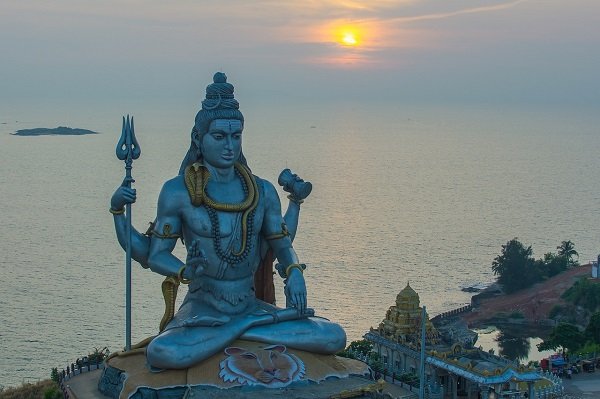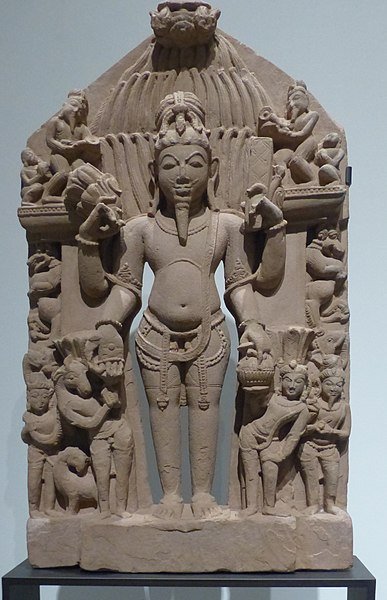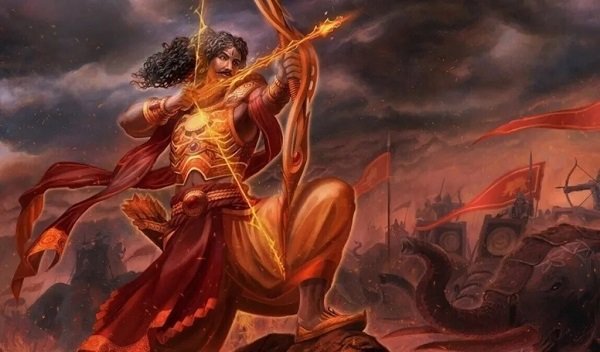Magical Objects Series - Part Eight: Hindu Mythology
Karna (in chariot) fighting Ghatotkacha (from the ‘Mahabharata’), statue in Rajasthan - photo by Mahimabhargava (WCommons)
The mythology surrounding Hinduism, one of the world’s oldest religions, is found in sacred Sanskrit texts like the Vedas, and heroic epics like the ‘Mahabharata’ and ‘Ramayana’.
The rich mythology contains stories of gods clashing with demons; gods, in the form of earth-bound avatars, restoring the order of the universe; and sages so powerful, they’re able to challenge, even curse, the gods.
There is no single definite version of the myths as the many characters have several roles and identities, and there are different versions of the stories, which isn’t surprising considering the complete scriptural texts date back about 3,000 years.
‘Nandaka’.
Sculpture of Vishnu wielding Nandaka - photo by Hans Stieglitz (WCommons)
The sword of Vishnu, who is also known as The Preserver as he protects the universe.
In Hindu scriptures, the sword represents knowledge.
According to the ‘Agni Purana’, Brahma, the creator-god, was attempting to perform a sacrifice but kept getting obstructed by an ‘asura’ (demon), who used his mace to drive other heavenly beings from the area.
Vishnu appeared from the sacrificial fire, seized the sword, Nandaka, from the asura and slew him.
The ‘Agni Purana’ is one of the 18 major Puranas (‘purana’ means ‘ancient’ or ‘old’), a vast genre of Hindu literature, written in Sanskrit, mainly about legends and traditional lore.
‘Kaladanda’.
Yama, god of death - photo by Nomu420 (WCommons)
This staff is used by Yama, the god of Death and Justice.
He is responsible for the punishment of sinners in his abode, ‘Yamaloka’ or ‘Naraka’, the equivalent of Hell.
One of the oldest deities in the Hindu pantheon, he is also one of the ‘Lokapalas’, the Guardians of the Directions, and he is the protector of the southern direction.
Once the kaladanda is thrown, it will kill its quarry; nothing can stop it and no boon can protect a living being from it.
Yama also holds a noose to capture the souls of those who have sinned.
‘Trishula’.
Shiva statue - photo by hari_mangayil (Pixabay)
The trident of Shiva, who is also known as The Destroyer, is believed to be one of the most powerful weapons.
The 3 points are commonly said to represent different trinities; examples include creation, preservation, and destruction; past, present, and future; compassion, joy, and love; clarity, knowledge, and wisdom; practice, understanding, and wisdom; death, ascension, and resurrection.
‘Astra’.
This supernatural weapon, which takes many forms, is presided over by a specific deity, depending on the form.
To summon or use an astra required use of a specific incantation.
The deity invoked would endow the astra with supernatural powers, making it impossible to counter through any ordinary method.
The user had to adhere strictly to the conditions attached to using the astra as any violation could be fatal.
Due to the immense power involved, the knowledge pertaining to an astra was passed by word of mouth alone from a ‘guru’ (teacher) to a ‘shishya’ (pupil), in a tradition known as the ‘Guru-shishya’.
‘Agneyastra’.
Agni, deity of fire - photo by Wolfgang Sauber (WCommons)
This weapon is an astra, and is presided over by Agni, the god of fire.
When shot, this weapon emits flames, inextinguishable through normal means.
‘Varunastra’.
Varuna, deity of water - British Museum collection (WCommons)
A weapon of water, this astra is presided over by Varuna, the god of water, and is considered the only viable counter to Agneyastra.
This astra, when discharged, would release torrential volumes of water.
‘Amrita’.
Vishnu, in the form of Mohini, distributing amrita to the devas (WCommons)
The drink of the gods or devas, said to grant them immortality even though it doesn’t confer true immortality.
Instead, it bestows a higher level of knowledge and power.
Due to being cursed by the sage, Durvasa, the devas had begun to lose their immortality.
They made a pact with their rivals, the asuras, and together, they churned the ocean, releasing many extraordinary objects, including a pitcher of amrita.
The asuras claimed the amrita for themselves, refusing to share with the devas.
Vishnu assumed the form of the enchantress Mohini and went among the asuras, using her beauty to persuade them to allow her to distribute the drink, and they agreed.
Mohini gave the drink to each of the devas then reverted to the form of Vishnu and proceeded to defeat the asuras.
‘Sanjivani’.
Hanuman returns with the mountain that has the sanjivani herb (WCommons)
This medicinal herb is powerful enough to revive those close to death.
Sanjivani is mentioned in the ‘Ramayana’ when Indrajit, Ravana’s son, hurls a powerful weapon at Lakshmana, Rama’s brother, leaving him mortally wounded.
Hanuman is sent to find the Sanjivani herb on the northern side of Mount Meru.
When he gets there, he finds other medicinal herbs, and is unable to identify the herb he needs.
As time is of the essence, Hanuman lifts the entire mountain and carries it back to Rama’s camp where the Sanjivani is used to successfully heal Lakshmana.
Lord Krishna & Arjuna (standing) - photo by Palagiri (WCommons) - from the ‘Mahabharata’
The last 2 items belong to/are used by characters from the ‘Mahabharata’ in the Kurukshetra War, a war of succession between 2 groups of royal cousins, the Kauravas and the Pandavas.
I’m going to give a very extreme shortened overview of how the war started or we’ll be here forever!
Pandu was crowned king of the Kuru Kingdom even though he had an elder brother, Dhritrashtra; the latter was denied the throne because he was blind.
Due to a curse laid on him by a powerful sage, Pandu was unable to conceive children naturally.
However, thanks to a boon granted to one of his wives by another sage, Pandu was blessed with 5 sons, fathered by different devas.
Soon afterwards, Pandu died, and the brothers were raised alongside their cousins, the 100 sons of Dhritrashtra, known as the Kauravas; the oldest, Duryodhana, had a deep hatred of his 5 cousins.
After the Kuru Kingdom was split to avoid succession disputes, the Pandavas founded the city of Indraprastha; the other parts of the kingdom were ruled by the Kauravas.
Unfortunately, the Pandavas lost their kingdom to Duryodhana when the oldest of the 5, Yudhishtira, gambled it away in a game of dice.
The bet had been that, if he lost, the Pandavas would hand their kingdom to the Kauravas and go into exile for 13 years.
When they returned 13 years later, the Kauravas refused to return the kingdom, and so began the Kurukshetra War.
The ‘Gandiva’ bow.
Arjuna statue, Bali - photo by Ilussion (WCommons)
This bow was created by Brahma, and, during the Kurukshetra War, was used by Arjuna, the 3rd Pandava brother, and the greatest archer.
Brahma had fashioned the Gandiva bow to safeguard Dharma; in ancient times, Dharma meant the laws of nature, which are applicable to all.
The bow was then passed to Shiva who held it for a millennium, after which it was passed on to other deities.
Eventually, over 1,500 years later, Varuna, the god of water, was handed the bow, which he held for a hundred years before granting it to Arjuna.
Endowed with great energy and said to be indestructible, the Gandiva bow bestowed on the wielder a heightened sense of self-confidence.
Karna ‘Kundala’, the earrings of Karna.
Karna (glorious hinduism)
Karna was the son of Surya, the sun god, and Kunti, a princess, making him a demigod; Kunti was also mother to 3 of the Pandava brothers, making Karna and Arjuna half-brothers, yet they fought on opposing sides.
Karna was born with earrings and mail, aspects of his divine father, which protected him from being slain in battle:
“Arrayed in your mail and earrings, you will be incapable of being slain by foes in battle. Do you lay to heart these words of mine. Both these jewelled ornaments have sprung from Amrita. Therefore, they should be preserved by you, if your life is at all dear to you.” (Surya’s words to Karna in the ‘Mahabharata’.)
However, despite the warning, Karna readily gave these up when asked by a Brahmin, who was actually Indra, the king of gods in disguise, as he held his reputation as one who always gives charity over his own life.
~~~~~~~~~~~~~~~~~~~~~~~~~~~~~~~~~~~~~~~~~~~~~~~~~~~~~~~~~~~~~~~~~~~~~~~~~~~~~~~~
And that’s the end of this series on magical objects.
It’s certainly been quite an interesting and enjoyable exercise, revisiting familiar objects and discovering new ones.
If you’ve checked out all 8 in the series, I thank you very much, and hope you’ve found some new favourites.










